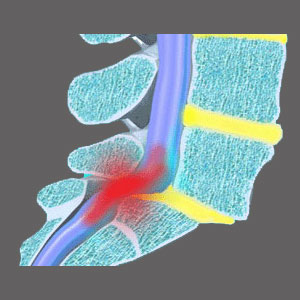
Lumbosacral spinal stenosis describes a narrowing of the central canal space in the region of the frontier which separates the lumbar spine from the sacrum. The lumbosacral juncture, as it is called, is the single most problematic location in the human spine, suffering a range of degenerative effects as a normal part of its lifespan and also being particular predisposed to traumatic injury.
The scope of this article will examine the anatomy of the lumbosacral junction and why spinal stenosis is so likely to occur here as we get older. However, we will also present evidence that many cases of stenosis in the low lumbar levels are coincidental to any symptoms which may be present.
What is Lumbosacral Spinal Stenosis?
The definition of lumbosacral stenosis is a decrease in the size of the central canal between the lumbar spine and the sacral spine. This intervertebral location is known to suffer from degenerative disc disease, a high incidence of herniation and active osteoarthritic activity in virtually every adult.
When the central canal is narrowed, the space that is required for neurological functionality is markedly decreased. Luckily, the spinal cord does not exist at L5/S1 and even the cauda equina is starting to thin out in the number of nerves passing through on their way to the sacrum and coccyx.
Since the neurological anatomy is small in size here, the canal would have to be almost completely sealed off in order to compress the cauda equina. Although this rarely occurs, it may take place in severe stenosis conditions.
Lumbosacral Spinal Stenosis Truths
As previously mentioned, it is completely normal to suffer various degenerative conditions in the lumbosacral spine and mild to moderate narrowing of the canal is typical past middle age. These conditions are seldom symptomatic, since the few remaining nerves of the cauda equina do not require much space to pass through unaffected.
If the stenosis is extreme, then a compressive neuropathy may exist in one or more nerves, causing symptoms anywhere in the lower anatomy. Typically, these symptoms will consist of various sciatica expressions and possibly lower back pain. Objective numbness, weakness, saddle paresthesia, incontinence of bladder or bowel and the inability to stand or walk all increase the chances that a significant stenosis condition exists. However, this stenosis can actually reside anywhere above the affected region, including the cervical or thoracic regions, as well, and still create similar symptomatic patterns.
Lumbosacral Spinal Stenosis Examination
Many instances of lumbosacral stenosis are misdiagnosed as the true cause of symptoms. In these circumstances, the degree of stenosis is normal and symptoms rarely even correlate. These patients are sometimes treated for an extended period of time conservatively and suffer poor outcomes. Most are then recommended for surgery and also demonstrate disappointing curative results. Of course this is to be expected, since the actual underlying cause of symptoms was never truly determined or treated.
Patients are advised to be very careful about subscribing to a diagnosis of lumbosacral stenosis if the structural changes found represent typical spinal degeneration. For patients who are accurately diagnosed and successfully treated, the prognosis is good. Although the degenerative processes will continue, most patients will be able to live the remainder of their days without a recurrence of severe stenotic activity in the same location.
Spinal Stenosis > Lumbar Spinal Stenosis > Lumbosacral Spinal Stenosis





